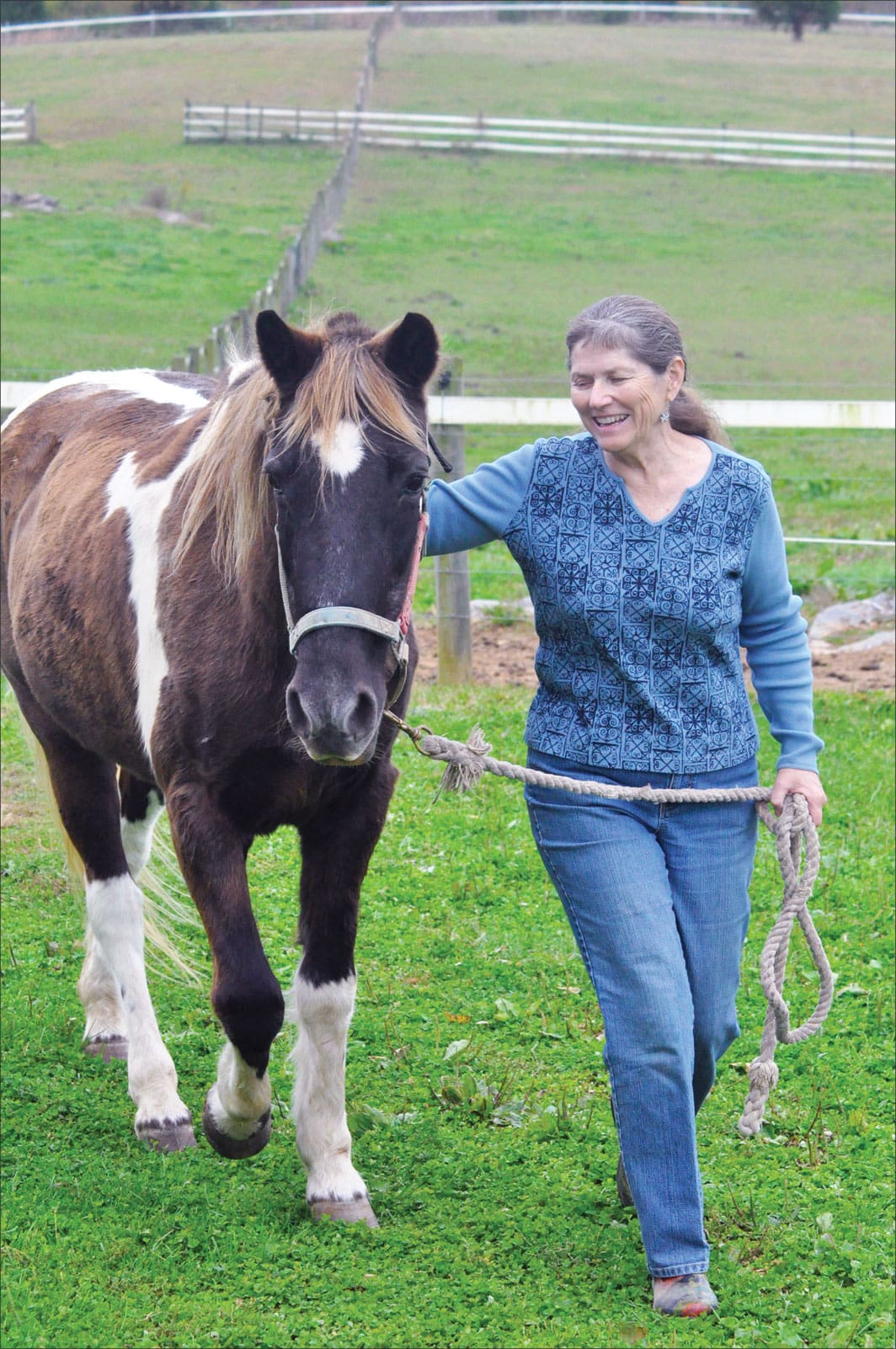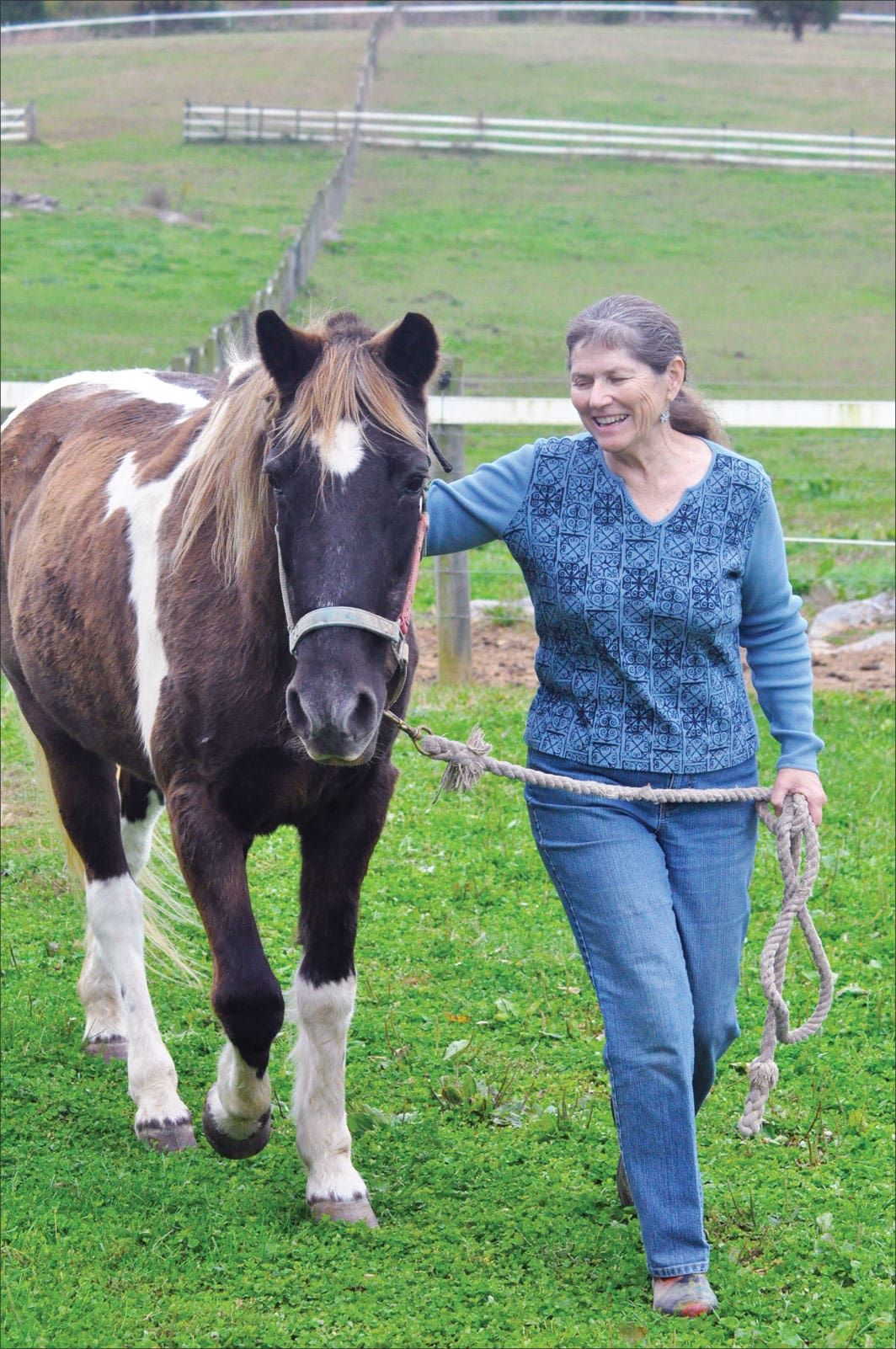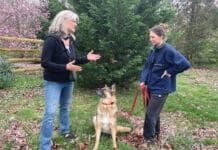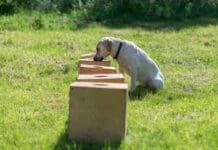There’s a good chance you’ve heard the phrase, “Any time you are with your dog you are training.” It’s commonly spoken by dog trainers as a way of reminding clients that their dogs are constantly being reinforced for behaviors – by the owner, by others, and by the environment. Behaviors that are reinforced increase in frequency, durability and strength. It behooves you to pay attention to what’s happening in your dog’s world so you can make sure he doesn’t have the opportunity to be reinforced for behaviors you don’t want, and even more importantly, so you can make sure you reinforce behaviors that you like.
Like the shoemaker’s children who run around barefoot, dog trainers’ dogs sometimes suffer from a paucity of formal training sessions. We are often busy working with other people and their dogs, and too tired to dedicate time to our own at the end of the day. That doesn’t mean, however, that we’re not training. I took a look at a day in my own life recently, as an example of how much training can happen if you just take advantage of reinforcement opportunities with your canine pal throughout the day.

288
5:30 am — The alarm goes off early here; time to do barn chores and get ready for the day. Paul heads downstairs first with Dubhy (Scottish Terrier) and Lucy (Cardigan Welsh Corgi). He calls them to follow him and reinforces the “Come” with a treat for each. (We both always have treats in pockets, and if we run out there’s a plastic container with treats on a shelf in every room in the house.)
6:00 am — I’ve finished getting dressed, making the bed, cleaning litterboxes and feeding the cats. My turn to head for the barn with Bonnie (Scorgidoodle) and Scooter (Pomeranian). Bonnie loves her crate and sometimes needs coaxing to come out. We take the opportunity to play “Find it!” – tossing treats on the floor for her to sniff out, and “Touch” – targeting to my hand for a “Yes!” marker and treats. (For more information about target training, see “Right on Target, WDJ February 2006.) While I use a clicker for formal training sessions, a verbal marker is a lot handier for real-life marking and treating.
6:02 am — I cue Bonnie to “Wait” at the top of the stairs so she won’t trip me as I carry Scooter down in my arms. (Scooter’s little Pom legs can’t navigate the stairs.) If Bonnie jumps the gun and starts down the stairs before I tell her to, we practice her “Back!” cue, and she backs up the stairs to the landing. No need to mark and reward Bonnie for the “Wait” – the release is reinforcement enough, and she flies to the back door in happy anticipation of the trip to the barn. (For more about the difference between wait and stay, see “Wait a Bit, Stay a While,” May 2001.)
6:04 am — After donning barn shoes and jacket I ask Bonnie and Scooter to “Wait” at the back door as I go out first – not because I have to be “dominant,” but because a good manners “Wait” behavior at the door prevents door-darting. The release cue invites them to follow. (Myths and misinformation about “dominance” is discussed in “Alpha Schmalpha,” December 2001.)
6:05 am — As we pass my Dodge Caravan I pop open the sliding door and invite Bonnie to hop in. She does so, willingly and eagerly, in happy anticipation of a “Yes” and treat. This is a deposit in the classical conditioning bank; Bonnie doesn’t like riding in cars and used to give the van a wide berth. By frequently inviting her to hop in, get a treat and not go for a ride, I’m helping her have a more positive association with cars and car rides.
6:07 am — I practice several recalls for high value treats with both Bonnie and Scooter on the way to the barn. Both dogs came to us from the shelter with tendencies to wander, or even dash off, when given outside freedom. I used to carry Scooter to the barn and walk Bonnie on a leash. Our daily recall practice has brought us to the point where they can reliably traverse the short distance to the barn under their own power, and Bonnie can hike off-leash with us around our 80-acre farm. (Scooter prefers not to go on hikes, thank you very much.)
6:15- 7:45 am — Lots of chances to reinforce a variety of behaviors for all four dogs as we feed, clean stalls, and move horses outside. An occasional “Wait” reminds them that they aren’t allowed to duck into the stalls and breakfast on fresh horse poo, or wander beneath horse hooves. Dubhy gets a treat for offering to perch on the mounting block – his “station” where we can send him if he gets underfoot during barn aisle sweeping. Bonnie might get reinforced for some lovely off-leash heeling down the barn aisle as she trots at my left side and gazes at my face.
We also play “Find it!” or “Down/Stay” to keep the dogs safely occupied as we lead horses out to their pastures, and “Wait” at barn gates so they don’t follow us outside. Dubhy also gets his daily wheelbarrow ride – “Dubhy, Up!” invites him to hop in, and he smiles all the way to the other end of the barn, where an “Unload!” prompts him to hop out onto a bench. The other three sit at my feet and I deliver treats all around.
8:00 am — Time for canine breakfast. All four gather in the kitchen as I prepare their bowls. I toss bits of cheese for Lucy to catch as I carry Scooter’s bowl to the laundry room, where he can eat without worry about harassment from the bigger dogs. The cheese reinforces Lucy for not barking as she waits for her own bowl. Lucy has some impulse control issues and a low tolerance for frustration. She sits on her mat while I deliver Dubhy and Bonnie’s meals to their mats on the opposite side of the kitchen.
Lucy deftly catches a cheese cube tossed from across the room – reinforcement for staying at her own spot until I come back to deliver her bowl. Each dog sits and waits until I place the bowl on the floor and release them to eat; that’s a super-reinforcement! (For more about using feeding time as a great opportunity to train behaviors such as “Off,”, “Wait,” and self-control, see “The Bowl Game,” July 2005.)
Continue to page 2 for the rest of the day!
9:00 am – 12:00 pm — This is mostly quiet time, with all four dogs napping as I work at my desk, but there are still opportunities, such as:

288
Barney-the-cat wanders into my office to hang out on my desk for a while, then hops down to carry on with his inscrutable cat business. There was a time when Lucy would chase him, but not any more. The sight of Barney jumping off my desk now means delivery of a high value treat; Lucy has been classically conditioned to look to me rather than chase the cat. To maintain that strong association, I still deliver the treat for every feline dismount. These days when Barney hops off my desk Lucy doesn’t even move, other than to glance at me in anticipation of a treat.
Scooter, little dude that he is, doesn’t give very big signals to tell us he has to go out, and has been known to lift his leg in the house. Lucy, herding dog that she is, is much more aware of his communications than I am, and will loudly inform me that Scooter is quietly saying he has to go out. Everyone gets reinforced for that one with a real-life reward – a trip to the fenced backyard – and a “Yes!” and treat for prompt responses to the “Go pee” cue. (See “Pee on Cue,” February 2007.)
While we’re out, I might play fetch with Lucy, and cue her to “Sit,” “Down,” “Back,” and “Give” – reinforcing each of those behaviors with another toss of her favorite fetch toy.
While she’s dashing off to retrieve, I sneak in a little practice of some of Dubhy’s tricks – “Sit up,” “Salute,” “Crawl,” “Roll Over,” and “Say Your Prayers.”
If Dubhy has wandered behind the corner of the garage, I seize the opportunity to call him back using his emergency whistle recall. We use a (very loud) Storm Whistle for this, both to overcome his mild hearing impairment, and to sharpen his sometimes-reluctant response to the recall. Dubhy is the only one of our four dogs who will often choose to stay out in the yard rather than come back in with the rest of the family.
(For more information about Storm whistles, see stormwhistles.com or call 314-436-3332. For more about building and maintaining a good recall, see “Rocket Recalls,” September 2012.)
On the way back inside, I pause for a moment to cue Bonnie to do a few swipes with her front paws on the canine emery board in the sunroom – encouraging her to file her own nails since she hates nail trimming. “Yes” and treat! Then I cue her to back up onto the board and wag her tail hard – the best technique we’ve found so far to file her back nails. More treats. (For more about how to teach a dog who really hates having her nails trimmed to enjoy having her nails trimmed, see “Positive Pedi-Pedis,” August 2012.)
12:00 – 5:00 pm — I usually work through lunch, writing or preparing for an afternoon client. Bonnie and Lucy hope for a dog-reactive dog client, since I use the two of them as my “neutral dogs” and they both love the assignment. Bonnie gets first dibs, since she’s the softer of the two, and most likely to help the client dog succeed with a counter-conditioning protocol. This is a great chance to work on heeling and focus, since I want my neutral dogs to be well controlled and not making eye contact with the client dog. We practice about turns, backing up, left and right turns, and Rally moves: moving downs, stays, finishes, 180s and 360s, as well as basic heeling and other tricks. When the client dog is ready to work with a second dog, Lucy goes through the same routines.
Alternatively, if there’s no client on the schedule, we might just go for a hike in the woods – a favorite activity for all of us except Scooter, who chooses to stay home.
Now we get to practice serious recalls – easy for Lucy, who has that herding dog propensity for staying close to her human, but it’s more difficult for Dubhy and Bonnie, who both have independent terrier attitudes. Bonnie ranges far enough to make me a little nervous, but since we started practicing recalls on the way to the barn a few years ago, she has become very reliable about returning when I call.
Dubhy hikes on a long line and wears a GPS tag. His adolescent months spent as a stray in the wilds of Chattanooga combined with his terrier independence make a reliable recall a real challenge for him.
The long line is probably not absolutely necessary. I know he will come most of the time; I just don’t want to take the chance that this time might be the exception. We practice recalls on the long line anyway, for that day that he does somehow slip away. It has happened a few times in the nine years we’ve been on the farm, and most of the time we’ve retrieved him pretty quickly. A recent exception when he was missing for a couple of hours (probably with his head down a groundhog hole in the woods) prompted the purchase of a GPS Tagg Pet Tracker.

Late in the afternoon, we do more barn chores, but the dogs usually stay inside for this feeding. We board horses, and often the boarders are out and about, and students are arriving for dog training classes. I cue Lucy to go to her office (which is my office) and Bonnie volunteers to go in her crate. Both get reinforced for complying – Lucy with a few tossed treats, and Bonnie with her favorite crate-chew: an orange! I do a little counter-conditioning for Scooter’s “I will bark and chase you out the door” behavior, by tossing a handful of treats on the floor as I leave.
8:00 pm — After the dogs’ dinner, which looks very much like their breakfast routine, it’s family time in the living room, and more reinforcement opportunities. Bonnie asks to get on the sofa by sitting at my feet and gazing beseechingly into my eyes. Permission to jump up is all the reinforcement she needs for that polite “Say Please” behavior.
Lucy also enjoys sofa time, so an occasional “Off” for one gets a treat reinforcement so the other can snuggle at my side for a while. Cameo appearances by Barney (the cat) provide more counter-conditioning moments to maintain the association in Lucy’s mind that “cats make treats happen!”

Dubhy pretty much keeps to himself in the evening, but a soft “Wuff” in the hallway for this hard-to-housetrain Scottie gets a well-deserved “outside” reinforcement, as does another announcement from Lucy that Scooter needs to go out.
11:00 pm — Last call for potty trips before bed. Everyone gets a treat for going out, and for coming back in when called.
The gang troops upstairs. Lucy and Bonnie get treats for speeding into their crates, Dubhy gets a couple of them for hopping into his bed (an antique wooden box with blankets for bedding), and Scooter gets treats on the bed and his two stuffed toys (“differential reinforcement of an incompatible behavior,” so he licks his toys instead of our pillows).
11:15 – 11:30 pm — Finally, we have a little end-of-day counter-conditioning/grooming time for Scooter. He has a very lush coat, with a dense undercoat that tangles incredibly easily, and needs brushing almost daily. Because it tangles so easily, grooming always involves some pulling, which is understandably aversive to him. To keep him happy about the brushing, he gets treats from one hand while I comb with the other.
Paul comes upstairs 15 to 30 minutes after I do, and I feed treats to Scooter to counter-condition/forestall his ferocious “burglar alert” barking.
NO TRAINING-TRAINING
So there you have it. For a day when I didn’t do any real “planned” training sessions, we have done a heck of a lot of reinforcement for desirable behaviors! (See “the Training Tally,” below, for the astonishing total.) In fact, I’m exhausted just writing about it.
If you don’t work at home, you will have fewer hours in the day with your dog, but this doesn’t necessarily mean you can’t take just as many opportunities to incorporate training into your daily routine. Ask her for some “Sit-Stays” and “Down-Stays” while you wait for your coffee to brew, interspersed with short sessions of Tug o’War. Invite your dog to accompany you to the laundry room, and ask her for different behaviors (Sit, Down, Stand, Shake Hands) as you sort or fold the clothes (and reward her for these behaviors!). Initiate a quick game of fetch from time to time while you help the kids with homework or cook dinner, asking her to sit politely each time before you toss the ball.
And of course, always be alert for opportunities to “catch her doing something right.” Offer her a reinforcing bit of attention, praise, petting, play, or food. Maintaining good behaviors is every bit as important as building new ones.






